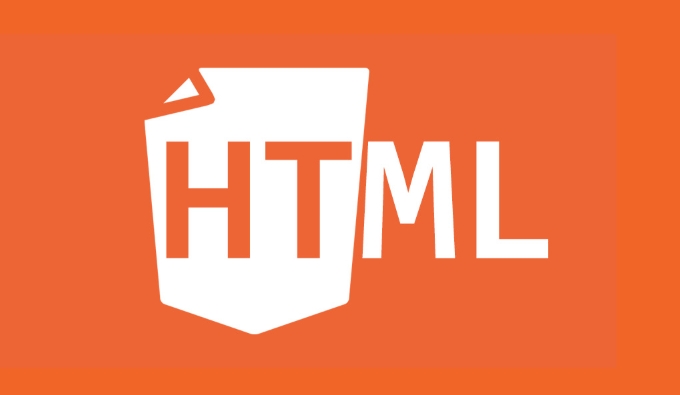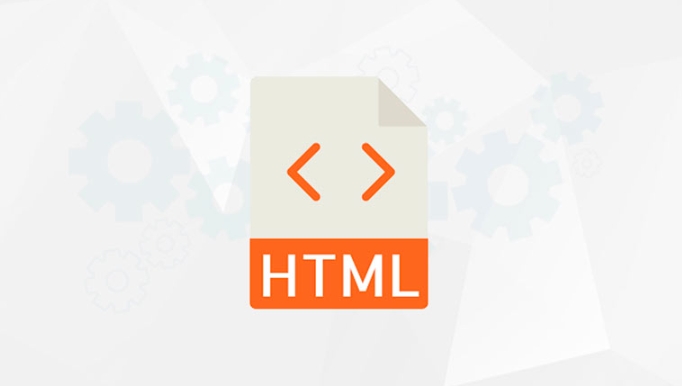Adding Developer Comments to HTML Source Code
Jul 09, 2025 am 12:29 AMAdding comments in HTML can improve code readability and team collaboration efficiency. Because HTML is a structured markup language, lacks obvious logical processes, and it is difficult to understand the role of blocks when the page is complex. At this time, the comments can be used as "navigation" to answer questions such as module purpose, dynamic content source, form behavior, etc. Effective comments should be clear and concise, and use the syntax of the . Common methods include explaining the purpose of the module (such as ), marking the boundaries of the code segments, and avoiding redundant explanations. Scenes suitable for annotation include page structure partitions, complex nesting areas, elements that require special processing and template reference locations. The unified annotation style is better when collaborating with teams, such as whether to use abbreviations, alignment, specific keywords, etc., which will help maintain and understand for a long time.

Adding developer comments to HTML source code is a good habit to improve code readability and team collaboration efficiency. Although these comments won't be displayed in the browser, they can help you or others quickly understand the code structure and functional intent.

Why comment in HTML?
HTML itself is a structured markup language, but it doesn't have obvious logical flows like JavaScript or CSS. When the page becomes larger and the structure becomes complex, it may be difficult to immediately understand the role of a certain block just by looking at the tags. At this time, adding a few short comments can play the role of "navigation".

for example:
- What does this
<div> do?<li> Is this content dynamically generated?</li> <li> Where will this form jump after submitting?</li> <p> These questions can be answered through comments to reduce the time cost of reading the code. </p> <img src="/static/imghw/default1.png" data-src="https://img.php.cn/upload/article/000/000/000/175199215797777.jpeg" class="lazy" alt="Adding Developer Comments to HTML Source Code"><h3 id="How-to-write-valid-HTML-comments"> How to write valid HTML comments?</h3> <p> The syntax of HTML comments is very simple: just wrap it with <code><!-- 注釋內容-->. The key is to write it usefully, clearly, and not overstatement.Here are some practical suggestions:
Explain the use of the module
For example:<!-- 導航欄開始--> ... <!-- 導航欄結束-->, so that others can know what this part does at a glance.Notes or to-do items
For example:<!-- TODO: 替換為動態(tài)菜單-->or<!-- 注意:此處依賴外部樣式-->Indicate the boundary of the code segment
If a part of the structure is very long, you can add comments at the beginning and end to facilitate folding and viewing.Avoid redundant explanations
There is no need to comment on each tag, such as<p>段落</p>so there is no need to write "This is a paragraph".
Which places are suitable for commenting?
Not all places require comments, but adding comments in the following scenarios can be helpful:
- Where the page structure is clearly separated (such as the head, sidebar, bottom)
- Areas containing complex nested structures
- Elements that require special processing (such as SEO-related meta tags, third-party script insertion points)
- Reference location for templates or components
For example:
<!-- Main content area--> <main class="content"> <article> ... </article> </main> <!-- /Main Content Area-->This kind of writing is very common in large-scale projects, especially when multiple people develop in collaboration.
The comment style can be unified and better
If you are writing a project alone, you can do whatever you want; but if you are in a team, it is best to unify the annotation style. for example:
- Whether to use abbreviation (such as
<!-- END nav -->or write in full<!-- 結束導航欄-->) - Is the comments aligned
- Whether to use specific keywords (such as TODO, FIXME)
Some teams will also cooperate with the construction tool to automatically check the annotation specifications, but this is an advanced gameplay.
Basically that's it. Comments are a small detail, but using them well can make the code easier to maintain and it is not easy to wrap yourself in.
The above is the detailed content of Adding Developer Comments to HTML Source Code. For more information, please follow other related articles on the PHP Chinese website!

Hot AI Tools

Undress AI Tool
Undress images for free

Undresser.AI Undress
AI-powered app for creating realistic nude photos

AI Clothes Remover
Online AI tool for removing clothes from photos.

Clothoff.io
AI clothes remover

Video Face Swap
Swap faces in any video effortlessly with our completely free AI face swap tool!

Hot Article

Hot Tools

Notepad++7.3.1
Easy-to-use and free code editor

SublimeText3 Chinese version
Chinese version, very easy to use

Zend Studio 13.0.1
Powerful PHP integrated development environment

Dreamweaver CS6
Visual web development tools

SublimeText3 Mac version
God-level code editing software (SublimeText3)

Hot Topics
 How to iterate over a Map in Java?
Jul 13, 2025 am 02:54 AM
How to iterate over a Map in Java?
Jul 13, 2025 am 02:54 AM
There are three common methods to traverse Map in Java: 1. Use entrySet to obtain keys and values at the same time, which is suitable for most scenarios; 2. Use keySet or values to traverse keys or values respectively; 3. Use Java8's forEach to simplify the code structure. entrySet returns a Set set containing all key-value pairs, and each loop gets the Map.Entry object, suitable for frequent access to keys and values; if only keys or values are required, you can call keySet() or values() respectively, or you can get the value through map.get(key) when traversing the keys; Java 8 can use forEach((key,value)->
 Java Optional example
Jul 12, 2025 am 02:55 AM
Java Optional example
Jul 12, 2025 am 02:55 AM
Optional can clearly express intentions and reduce code noise for null judgments. 1. Optional.ofNullable is a common way to deal with null objects. For example, when taking values ??from maps, orElse can be used to provide default values, so that the logic is clearer and concise; 2. Use chain calls maps to achieve nested values ??to safely avoid NPE, and automatically terminate if any link is null and return the default value; 3. Filter can be used for conditional filtering, and subsequent operations will continue to be performed only if the conditions are met, otherwise it will jump directly to orElse, which is suitable for lightweight business judgment; 4. It is not recommended to overuse Optional, such as basic types or simple logic, which will increase complexity, and some scenarios will directly return to nu.
 How to fix java.io.NotSerializableException?
Jul 12, 2025 am 03:07 AM
How to fix java.io.NotSerializableException?
Jul 12, 2025 am 03:07 AM
The core workaround for encountering java.io.NotSerializableException is to ensure that all classes that need to be serialized implement the Serializable interface and check the serialization support of nested objects. 1. Add implementsSerializable to the main class; 2. Ensure that the corresponding classes of custom fields in the class also implement Serializable; 3. Use transient to mark fields that do not need to be serialized; 4. Check the non-serialized types in collections or nested objects; 5. Check which class does not implement the interface; 6. Consider replacement design for classes that cannot be modified, such as saving key data or using serializable intermediate structures; 7. Consider modifying
 Java Socket Programming Fundamentals and Examples
Jul 12, 2025 am 02:53 AM
Java Socket Programming Fundamentals and Examples
Jul 12, 2025 am 02:53 AM
JavaSocket programming is the basis of network communication, and data exchange between clients and servers is realized through Socket. 1. Socket in Java is divided into the Socket class used by the client and the ServerSocket class used by the server; 2. When writing a Socket program, you must first start the server listening port, and then initiate the connection by the client; 3. The communication process includes connection establishment, data reading and writing, and stream closure; 4. Precautions include avoiding port conflicts, correctly configuring IP addresses, reasonably closing resources, and supporting multiple clients. Mastering these can realize basic network communication functions.
 Comparable vs Comparator in Java
Jul 13, 2025 am 02:31 AM
Comparable vs Comparator in Java
Jul 13, 2025 am 02:31 AM
In Java, Comparable is used to define default sorting rules internally, and Comparator is used to define multiple sorting logic externally. 1.Comparable is an interface implemented by the class itself. It defines the natural order by rewriting the compareTo() method. It is suitable for classes with fixed and most commonly used sorting methods, such as String or Integer. 2. Comparator is an externally defined functional interface, implemented through the compare() method, suitable for situations where multiple sorting methods are required for the same class, the class source code cannot be modified, or the sorting logic is often changed. The difference between the two is that Comparable can only define a sorting logic and needs to modify the class itself, while Compar
 Java method references explained
Jul 12, 2025 am 02:59 AM
Java method references explained
Jul 12, 2025 am 02:59 AM
Method reference is a way to simplify the writing of Lambda expressions in Java, making the code more concise. It is not a new syntax, but a shortcut to Lambda expressions introduced by Java 8, suitable for the context of functional interfaces. The core is to use existing methods directly as implementations of functional interfaces. For example, System.out::println is equivalent to s->System.out.println(s). There are four main forms of method reference: 1. Static method reference (ClassName::staticMethodName); 2. Instance method reference (binding to a specific object, instance::methodName); 3.
 How to handle character encoding issues in Java?
Jul 13, 2025 am 02:46 AM
How to handle character encoding issues in Java?
Jul 13, 2025 am 02:46 AM
To deal with character encoding problems in Java, the key is to clearly specify the encoding used at each step. 1. Always specify encoding when reading and writing text, use InputStreamReader and OutputStreamWriter and pass in an explicit character set to avoid relying on system default encoding. 2. Make sure both ends are consistent when processing strings on the network boundary, set the correct Content-Type header and explicitly specify the encoding with the library. 3. Use String.getBytes() and newString(byte[]) with caution, and always manually specify StandardCharsets.UTF_8 to avoid data corruption caused by platform differences. In short, by
 How to parse JSON in Java?
Jul 11, 2025 am 02:18 AM
How to parse JSON in Java?
Jul 11, 2025 am 02:18 AM
There are three common ways to parse JSON in Java: use Jackson, Gson, or org.json. 1. Jackson is suitable for most projects, with good performance and comprehensive functions, and supports conversion and annotation mapping between objects and JSON strings; 2. Gson is more suitable for Android projects or lightweight needs, and is simple to use but slightly inferior in handling complex structures and high-performance scenarios; 3.org.json is suitable for simple tasks or small scripts, and is not recommended for large projects because of its lack of flexibility and type safety. The choice should be decided based on actual needs.






